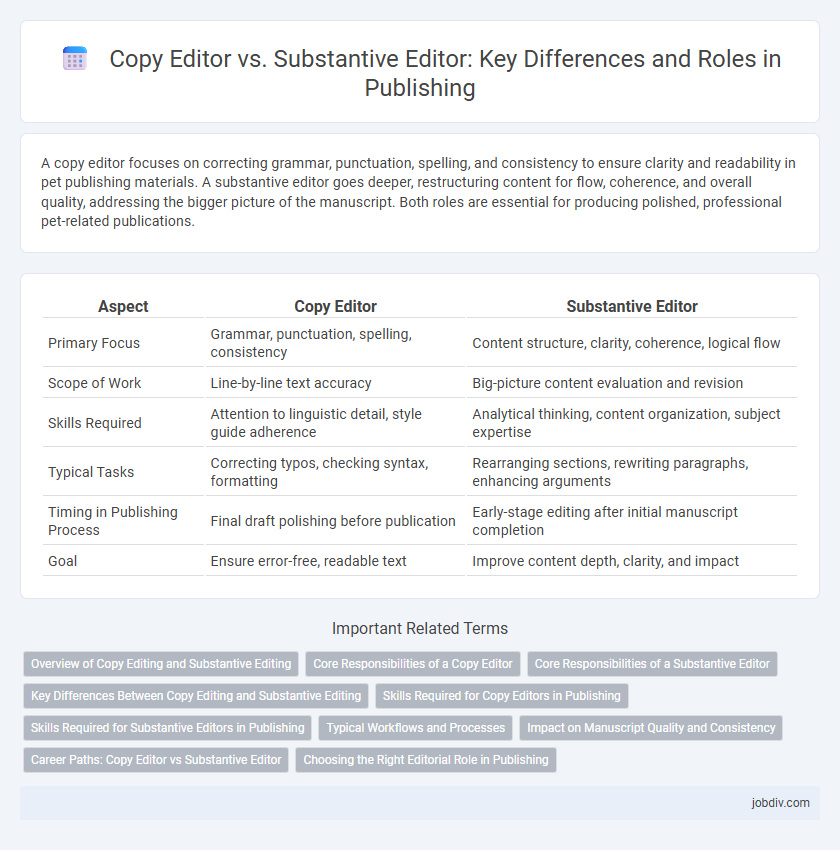A copy editor focuses on correcting grammar, punctuation, spelling, and consistency to ensure clarity and readability in pet publishing materials. A substantive editor goes deeper, restructuring content for flow, coherence, and overall quality, addressing the bigger picture of the manuscript. Both roles are essential for producing polished, professional pet-related publications.
Table of Comparison
| Aspect | Copy Editor | Substantive Editor |
|---|---|---|
| Primary Focus | Grammar, punctuation, spelling, consistency | Content structure, clarity, coherence, logical flow |
| Scope of Work | Line-by-line text accuracy | Big-picture content evaluation and revision |
| Skills Required | Attention to linguistic detail, style guide adherence | Analytical thinking, content organization, subject expertise |
| Typical Tasks | Correcting typos, checking syntax, formatting | Rearranging sections, rewriting paragraphs, enhancing arguments |
| Timing in Publishing Process | Final draft polishing before publication | Early-stage editing after initial manuscript completion |
| Goal | Ensure error-free, readable text | Improve content depth, clarity, and impact |
Overview of Copy Editing and Substantive Editing
Copy editing involves refining grammar, punctuation, spelling, and consistency to ensure clarity and correctness at the sentence level. Substantive editing focuses on the manuscript's overall structure, content flow, tone, and coherence, addressing issues such as organization, argument strength, and factual accuracy. Both roles are essential in publishing to produce polished, well-structured, and engaging texts that meet editorial standards.
Core Responsibilities of a Copy Editor
A copy editor is responsible for enhancing text clarity, correcting grammar, punctuation, and spelling errors, and ensuring consistency in style and formatting across a manuscript. They focus on refining language, eliminating redundancies, and maintaining the publication's voice while preparing content for final production. Unlike substantive editors who address structural and conceptual elements, copy editors concentrate on sentence-level accuracy and readability.
Core Responsibilities of a Substantive Editor
A Substantive Editor focuses on the overall structure, content flow, and clarity of a manuscript, ensuring ideas are logically organized and fully developed to meet the target audience's needs. They analyze and enhance narrative coherence, argument strength, and tone consistency, often suggesting major rewrites or reorganization to improve the work's impact. Their core responsibility is to transform the manuscript into a polished, compelling, and publication-ready document by addressing depth and substance beyond basic grammar or style corrections.
Key Differences Between Copy Editing and Substantive Editing
Copy editing focuses on correcting grammar, spelling, punctuation, and consistency to ensure the text is polished and error-free, while substantive editing involves restructuring content, improving clarity, and evaluating the overall flow and coherence of the manuscript. Copy editors address surface-level issues, ensuring adherence to style guides and factual accuracy, whereas substantive editors engage deeply with the material, often suggesting changes to organization, tone, and argument strength. The key differences lie in the scope of work, with copy editing enhancing technical precision and substantive editing transforming content quality and reader engagement.
Skills Required for Copy Editors in Publishing
Copy editors in publishing must possess exceptional attention to detail and mastery of grammar, punctuation, and style guides like AP or Chicago Manual of Style to ensure text accuracy and consistency. Proficiency in fact-checking, familiarity with digital editing tools, and the ability to maintain the author's voice while correcting errors are critical skills for producing polished, publishable content. Strong communication skills enable copy editors to collaborate effectively with authors and substantive editors during the revision process.
Skills Required for Substantive Editors in Publishing
Substantive editors in publishing require advanced skills in content analysis, structural organization, and in-depth subject matter knowledge to enhance the manuscript's coherence and impact. Proficiency in critical thinking and the ability to identify inconsistencies, logical gaps, and factual errors are essential for refining complex narratives or technical material. Strong communication skills enable substantive editors to collaborate effectively with authors, ensuring clarity, tone, and style consistency throughout the publication.
Typical Workflows and Processes
Copy editors focus on refining grammar, punctuation, and style consistency during the final stages of manuscript preparation, ensuring clarity and adherence to publishing standards. Substantive editors engage earlier by evaluating the overall structure, content coherence, and flow, making significant adjustments to improve narrative and argument development. Typical workflows often involve substantive editing first to reshape content, followed by copy editing to polish language and format before publication.
Impact on Manuscript Quality and Consistency
Copy editors meticulously correct grammar, punctuation, and spelling errors to ensure clarity and polish in the manuscript, directly enhancing readability and consistency. Substantive editors focus on the manuscript's overall structure, content coherence, and argument strength, significantly improving the depth and quality of the narrative. Together, their expertise ensures the manuscript is both technically flawless and intellectually compelling, maximizing its impact on the target audience.
Career Paths: Copy Editor vs Substantive Editor
Career paths for copy editors often focus on refining grammar, punctuation, and style consistency, making them essential in producing polished manuscripts. Substantive editors, also known as developmental editors, pursue careers centered on shaping content structure, clarity, and overall narrative flow to improve the manuscript's impact. Advancement opportunities in substantive editing may lead to senior editorial roles or content strategy positions, while copy editors can evolve into proofreaders or editorial coordinators within publishing houses.
Choosing the Right Editorial Role in Publishing
Choosing the right editorial role in publishing depends on the project's needs: a copy editor ensures grammar, punctuation, and consistency are flawless, while a substantive editor focuses on structure, content clarity, and overall narrative flow. Copy editors refine the manuscript's technical accuracy and style adherence, making the text polished and professional. Substantive editors delve deeper into content, reorganizing sections, suggesting improvements for argument coherence, and enhancing the text's impact on its target audience.
Copy Editor vs Substantive Editor Infographic

 jobdiv.com
jobdiv.com